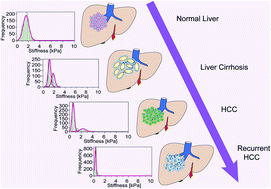The nanomechanical signature of liver cancer tissues and its molecular origin†
Abstract
Patients with cirrhosis are at higher risk of developing hepatocellular carcinoma (HCC), the second most frequent cause of cancer-related deaths. Although HCC diagnosis based on conventional morphological characteristics serves as the “gold standard” in the clinic, there is a high demand for more convenient and effective diagnostic methods that employ new biophysical perspectives. Here, we show that the nanomechanical signature of liver tissue is directly correlated with the development of HCC. Using indentation-type atomic force microscopy (IT-AFM), we demonstrate that the lowest elasticity peak (LEP) in the Young's modulus distribution of surgically removed liver cancer tissues can serve as a mechanical fingerprint to evaluate the malignancy of liver cancer. Cirrhotic tissues shared the same LEP as normal tissues. However, a noticeable downward shift in the LEP was detected when the cirrhotic tissues progressed to a malignant state, making the tumor tissues more prone to microvascular invasion. Cell-level mechanistic studies revealed that the expression level of a Rho-family effector (mDia1) was consistent with the mechanical trend exhibited by the tissue. Our findings indicate that the mechanical profiles of liver cancer tissues directly varied with tumor progression, providing an additional platform for the future diagnosis of HCC.


 Please wait while we load your content...
Please wait while we load your content...